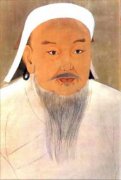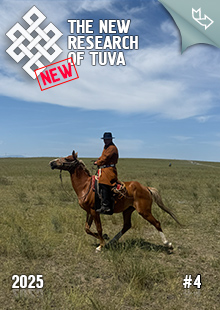 According to legend, Genghis-khan was buried in a place which he himself pointed out, on the slope of one of the peaks of the mountain massif Burkhan-Khaldun - a sacred mountain of ancient Mongols. This mountain once save young Temujin's life, hiding him in its inaccessible thickets and crevices; he always came here before portentous events for the support of the supreme deity of the Mongols, Eternal Blue Heaven, a deity living on mountain peaks, among holy springs. Three rivers originate here - Onon, Kerulen and Tuula.
According to legend, Genghis-khan was buried in a place which he himself pointed out, on the slope of one of the peaks of the mountain massif Burkhan-Khaldun - a sacred mountain of ancient Mongols. This mountain once save young Temujin's life, hiding him in its inaccessible thickets and crevices; he always came here before portentous events for the support of the supreme deity of the Mongols, Eternal Blue Heaven, a deity living on mountain peaks, among holy springs. Three rivers originate here - Onon, Kerulen and Tuula.
"One day, hunting in these places, Genghis-Khan stopped to rest under the crown of a huge lone tree. Having spent some time there in a condition of semi-forgetfulness, then he got up and said that he would like to be buried precisely there when he dies," - states the legend.
After the funeral ceremony the burial place was hidden, to protect the ruler from presumptuous curiosity of mere mortals. Even as his body was being conveyed to the place of the last rest of the great conqueror , the guards killed all the more or less suspicious strangers who showed up along the route of progression of the funerary cortege. Later rumors started spreading that the killings of innocent people took place in order to preserve the secrecy of the burial; the leader's tomb could be robbed without appropriate security measures.
However, it was not quite so. Without discarding the version about preserving the secrecy of Genghis-Khan's burial location, we have to turn our attention to two other associated circumstances. First, according to the ancient Altai custom, the deceased had to be supplied with servants in the world beyond the grave. For that purpose, not only people were sacrificed, but horses and domestic cattle as well, with the saying: "Go serve our master in the other world!" second, the government officials tried not to let the news about Genghis-Khan's death spread prematurely among the peoples who were the Mongols' enemies, or those who were conquered by them only recently.
The sum of these precautions, plus the beliefs and customs, turned the burial of the Ruler of the Universe into a riddle for the researchers. The territory of contemporary Mongolia is larger than territory of France, and it is sparsely populated. The Siberian taiga lies to the north, which is ruled by cold and snow for two thirds of the year. In the opposite direction lies an endless steppe, ending in the sands of the Gobi desert.
On the web site "Field Expedition Mongolia" which was created by an investigator from a California university Albert Lin and his colleagues, together with the National Geographic journal, there are about 85,000 satellite photographs of the territory of Mongolia. More than 8 thousand volunteers from all corners of the world have been participating in this scientific project, which received the name "Valley of the Khans Project", searching through the wide-angle photos step by step to find Genghis-Khan's tomb.
With the help of the teaching online-program, detailed instructions are supplied, how to search and mark the reviewed objects. The images of a large territory can be enlarged or shrunk, as well as turn in any direction.
The site visitors who are working with the project are asked to mark places on the map which seem interesting to them. The computer can overlook something significant, while human eyes or intuition can prompt a more thorough search.
During the expedition last year the company surveyed places in Mongolia which were suggested by the voluntary helpers. They rode on horseback for hundreds of miles, and even more miles in helicopters, but from the entire multitude of places noted by the internet-users, they managed to find only one Bronze Age tomb and some ruins.
And even though, in Lin's opinion, he could not have found these artifacts from horseback, let's say honestly: it is extremely little for a project, the aim of which is to increase the effectiveness of archeological searches and to decrease the expenses. There were also some amusing incidents. The pseudo-archeologists sitting at the monitors marked herds of migrating sheep as tomb kurgans . Just as if Genghis-Khan's spirit was demonstrating the wonders of teleportation!
Mr. Lin proposes seriously to make science entertaining, and so that he would not have to pay people, he offers them to play at a search for Genghis-Khan's tomb where it never was. His proposal is somewhat reminiscent of a hero of an old humoristic miniature Arkadiy Raikin, who proposed to tie a generator to a ballerina's leg so that she would produce electric current "for outlying districts" while dancing.
And suddenly some wheelchair-bound know-it-all , staring into his computer, will make a discovery that would make Heinrich Schliemann turn over in his grave with envy. Of course, it is a praiseworthy aim and fits in with the politically correct direction. Why waste time socializing in web-sites and dully read articles on the internet (like this one). Go look for Captain Flint's or Genghis-Khan's treasure!
Nevertheless, a year after time uselessly wasted in Mongolia, Lin started thinking about creating a virtual expedition, which would be associated with the real expedition and would allow to pay at least a little bit for the wasted time.
In his interviews, Lin, as before, puts emphasis on the search performed free by thousands of dilettantes. Hopefully, this may stimulate interest in history in general and archeology in particular.
Creator of an empire much larger than the Roman Empire, Genghis-Khan was most probably born in 1162. True, in childhood and youth he was called Temujin, and he was the eldest of five brothers. His father Yesugei the Brave died when the future ruler was only a juvenile. Yesugei was the leader of a sub-clan of Kiyats - a subdivision of the royal clan of Borjigins. After defeating several enemy leaders, he named his oldest son in honor of one of them - Temujin. Just like Philipp of Macedonia put the foundation to the future might of his son Alexander the Great, by creating the remarkable Macedonian phalange, Genghis-Khan's father, by securing an alliance with the Keraits, created a foundation for the entire policy of his son.
"Keraits were one of the most mysterious people in history, because it is not clear to this day of what descent they were: mostly Turkic or more likely Mongolian. The first mention of them showed up in the chronicles associated with the generation just before Genghis-Khan, and these chronicles ascribed them very significant role, - as French historian Rene Grousset writes. It is the typical fate of the steppe empires which form in several years, and disintegrate just as quickly. Even the location of their nomadic grounds is not known."
The state created by Genghis-Khan existed for more than a hundred years, but to create it, almost half of the clans of Mongolian nobles had to be destroyed. The contemporaries remarked that law and order ruled in his empire. Genghis-Khan was not just a great military conqueror, but also a statesman. He is respected as the creator of the Mongol law - Yassa. In this regard, Genghis-Khan may even surpass Napoleon with his Codex.

